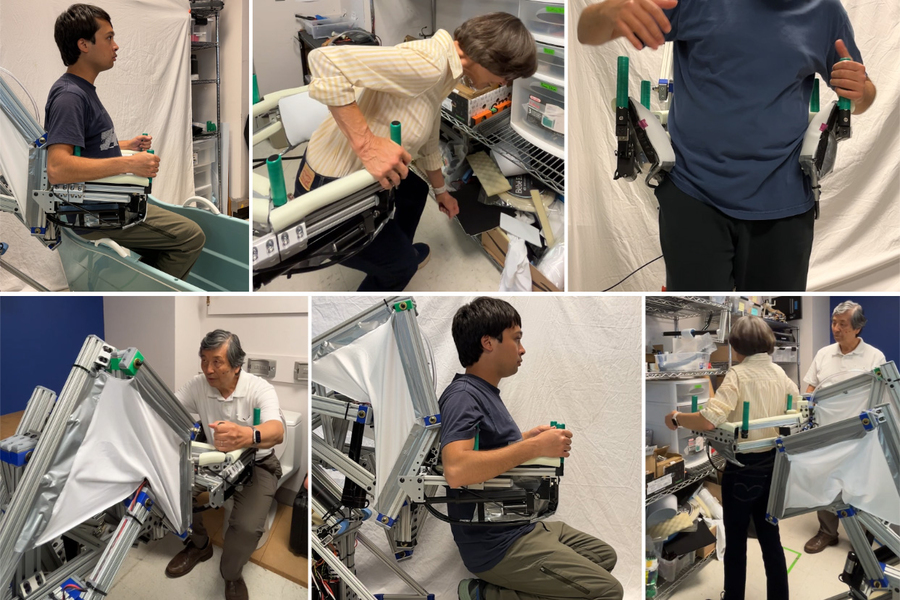Engineers at the Massachusetts Institute of Technology (MIT) in the US have built and tested a mobile robot designed to physically support elderly people and prevent them from falling as they move around their homes.
The Elderly Bodily Assistance Robot (E-BAR) was designed in a bid to address the challenges of an ageing population, the prevalence of falls among older people, and a shortage of care workers.
E-BAR acts as a set of robotic handlebars that follows a person from behind. A user can walk independently or lean on the robot’s arms for support. The robot can support the person’s full weight, lifting them from sitting to standing and vice versa along a natural trajectory.
Importantly, the arms of the robot can catch them by rapidly inflating side airbags if they begin to fall.
Harry Asada, the Ford Professor of Engineering at MIT, said: “Many older adults underestimate the risk of fall and refuse to use physical aids, which are cumbersome, while others overestimate the risk and may not exercise, leading to declining mobility.
“Our design concept is to provide older adults having balance impairment with robotic handlebars for stabilising their body. The handlebars go anywhere and provide support anytime, whenever they need.”
In its current version, the robot is operated via remote control. In future iterations, the team plans to automate much of the assistive device’s functionality, enabling it to autonomously follow and physically assist a user.
The researchers are also working on streamlining the device to make it slimmer and more manoeuvrable in small spaces.
In designing E-BAR, Harry and E-BAR designer Roberto Bolli, a graduate student in the MIT Department of Mechanical Engineering, aimed for a robot that does three tasks: providing physical support, preventing falls, and safely and unobtrusively moving with a person. They looked to do away with any harness, to give a user more independence and mobility.
“Elderly people overwhelmingly do not like to wear harnesses or assistive devices,” Roverto explained. “The idea behind the E-BAR structure is it provides body weight support, active assistance with gait, and fall catching while also being completely unobstructed in the front. You can just get out anytime.”
The team looked to design a robot specifically for ageing in place at home or helping in care facilities. Based on their interviews with older adults and their carers, they came up with several design requirements, including that the robot must fit through home doors, allow the user to take a full stride, and support their full weight to help with balance, posture, and transitions from sitting to standing.
The robot consists of a heavy base that can support the weight of an average human without tipping or slipping. It features a set of omnidirectional wheels that allows the robot to move in any direction without pivoting, if needed.
Extending out from the robot’s base is an articulated body made from 18 interconnected bars that can reconfigure like a foldable crane to lift a person from a sitting to standing position, and vice versa. Two arms with handlebars stretch out from the robot in a U-shape, which a person can stand between and lean against if they need additional support.
Finally, each arm of the robot is embedded with airbags made from a soft yet grippable material that can inflate instantly to catch a person if they fall, without causing bruising on impact. The researchers believe that E-BAR is the first robot able to catch a falling person without wearable devices or use of a harness.
They tested the robot in the lab with an older adult who volunteered to use the robot in various household scenarios.
The team found that E-BAR could actively support the person as they bent down to pick something up from the ground and stretched up to reach an object off a shelf, tasks that can be challenging to do while maintaining balance. The robot also was able to lift the person up and over the lip of a tub, simulating the task of getting out of a bathtub.
Roberto envisions a design like E-BAR would be ideal for use in the home by elderly people who still have a moderate degree of muscle strength but require assistive devices for activities of daily living.
In their current paper, the researchers did not incorporate any fall-prediction capabilities in E-BAR’s airbag system.
Learn more about E-BAR and see the assistive device in action in the video below.
The post Video: MIT engineers develop a robot that catches a falling person without wearable devices or a harness appeared first on AT Today – Assistive Technology.

